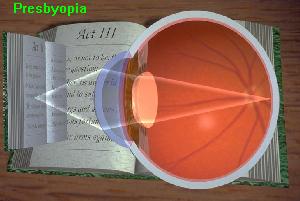The Farsighted
Eye
Presbyopia affects 100% of the population by age 50.
Currently, bifocals are the only highly successful way to treat presbyopia.
 |
The crystalline lens
allows the eye to vary its optical power, permitting individuals with normal vision to
view distant objects and refocus their eyes to see near objects sharply. This ability
begins to decline around age 40 with the onset of presbyopia (literally "old
eye") when the lens starts to lose its flexibility. |
Presbyopic individuals with normal vision need reading
glasses while nearsighted and farsighted patients need bifocals for clear viewing at both
distance and near.
People who have low myopia (3 diopters or less) often notice that they can read fine print
comfortably without their glasses well past the age of 40. This is because their
nearsightedness allows them to focus at near without the use of any additional optical
power from their crystalline lens.
Spectacle Correction:
Bifocal lenses allow the user to view distance objects
through the top portion of their glasses, and near objects with magnifiers added to the
bottom portion of their glasses. Recently, these lenses can be blended together to produce
a "progressive add" or "no line" bifocal.
Special Refractive Surgery
Considerations:
It is important that you understand that refractive surgery
DOES NOT PREVENT the age-related loss of the eye's ability to vary its focusing
power. If you are over 40 and have both your eyes fully corrected for distance vision, you
will need reading glasses for near work. As an alternative to reading glasses for near
work, you may elect to leave one eye slightly nearsighted; an outcome called monovision.
